Engineers know the value of solid and reliable soldering and desoldering stations. From carrying out simple soldering tasks to repairing and reworking surface-mount technology (SMT) boards, integrated circuits (ICs) and multi-layer boards, these stations are handy tools to have for every design engineer, technician, hobbyist or electronic enthusiast. In this article, we take a look at some of the latest features in soldering and desoldering stations, while highlighting the important parameters to consider before buying these for your applications.
Different kinds of stations available
Usage of soldering and desoldering stations range from very minute straight-forward jobs to heavy-duty applications. Based on the requirement and application, different stations are available, varying in power consumption, temperature range, microcontroller (MCU) based control and other features.
Contact soldering stations are the most common and popular kind of soldering stations. Abhishek Rao, technical marketing manager, element14 India, says, “These have a built-in power supply unit, which, in most cases, ensures the galvanic separation between the power circuit and the heating element.” He adds, “Voltage on the heating element can be adjusted using the power supply unit and the heating temperature can be changed accordingly.”
Lead-free soldering stations are another category that is used to wire lead-free printed circuit boards (PCBs). These usually make use of lead-free solders and are not necessarily expensive. With many developed nations making regulations favouring lead-free soldering, these stations could come in handy for future applications. Rao says, “Lead-free soldering stations are specially designed for working with lead-free solders, which offer good reliability and good solderability.”
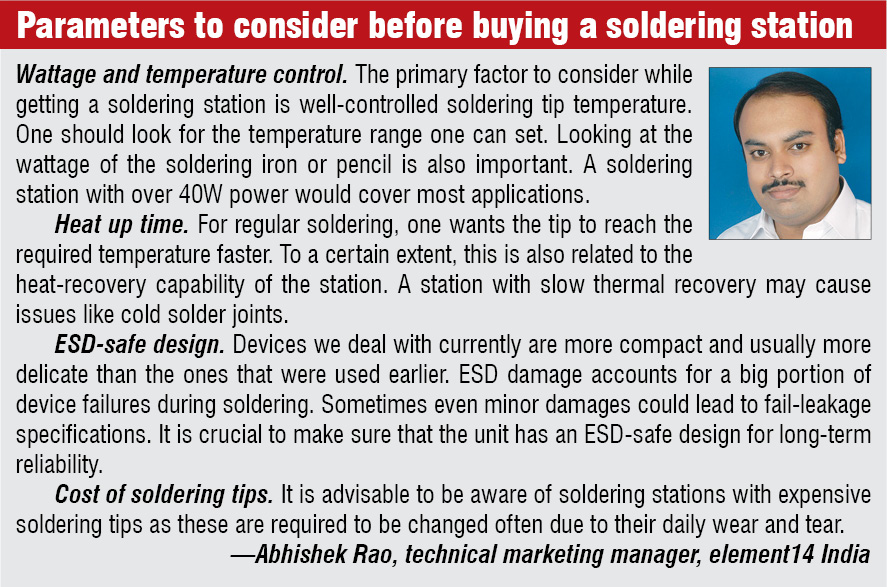
Although, lead-free stations have their own share of cons such as requirement of extra heat to melt lead-free solder, which, in turn, affects the tip of the soldering iron. Most of the reputed manufacturers educate their buyers on ideal usage of lead-free soldering stations, which helps them maintain and extend the life of soldering tips.
Soldering stations are also packaged with different kinds of heaters. “Ceramic heaters, induction coil heaters and combination of heater, sensor and soldering tip integrated into one tool are some other variations in soldering stations,” says V. Ramavallabhan, management and technical consultant, JVR Consultants.
Hot-air rework and desoldering stations are generally used for removing components from PCBs and re-soldering new ones. While rework stations are ideal for simple jobs, desoldering stations are mostly used for demanding reworks on PCB boards and are comparatively less expensive.
Rao says, “Hot-air soldering stations are optimum for professionals and hobbyists because these can be used for preheating components before removing or can be used to reflow SMT components such as dual inline packaging (DIP), small outline integrated circuits (SOICs), quad flat packages (QFPes) and other ICs.”
He adds, “Infrared (IR) soldering stations are the most progressive solution in soldering of complex elements. IR light helps prevent mechanical damage and overheating of components due to concentration of the radiation beam of the IR spectrum at focal point.”
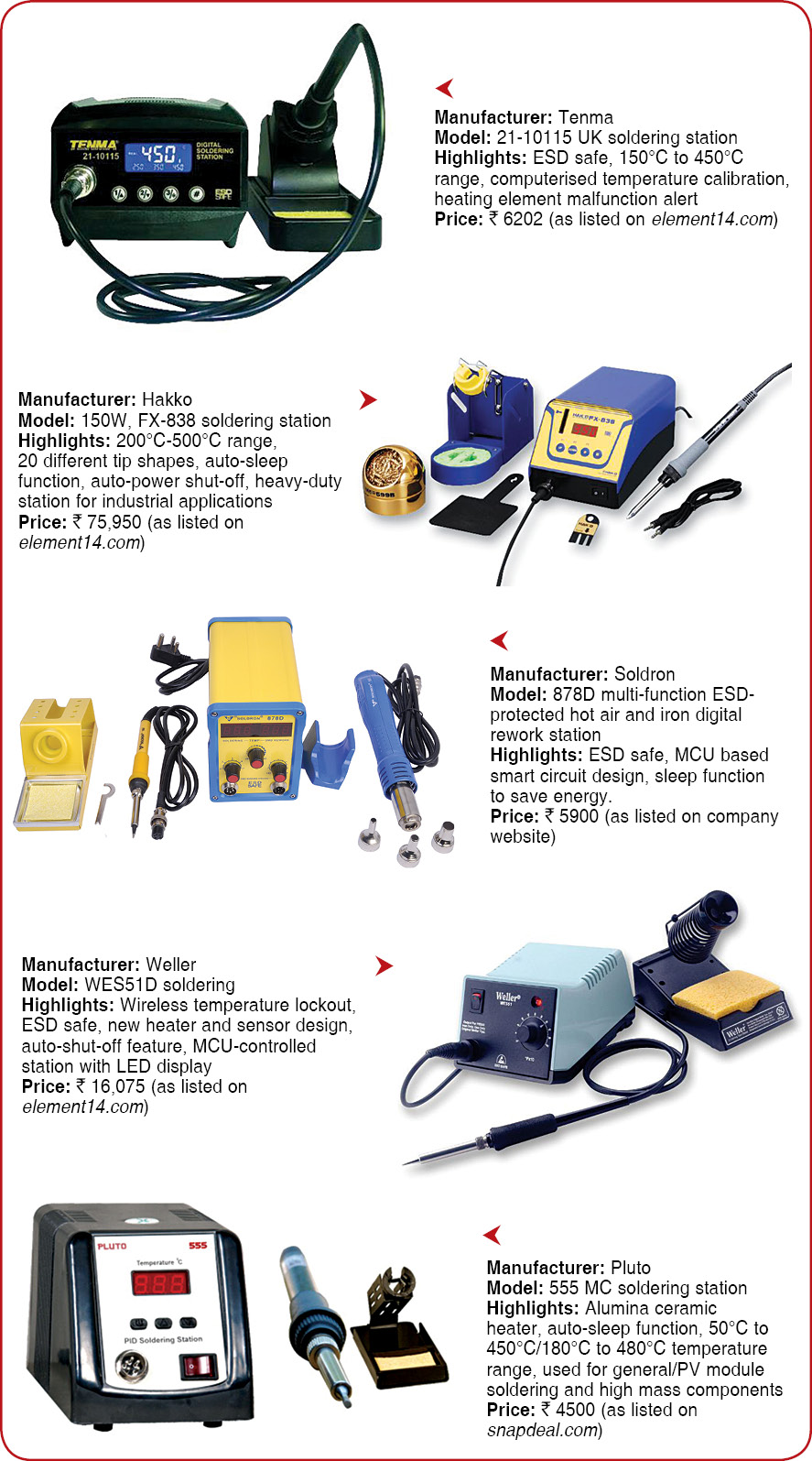 Interesting features and their benefits
Interesting features and their benefits
Soldering and desoldering stations are a must have for all electronics professionals. Nowadays, all stations are electrostatic discharge (ESD) safe, Restriction of Hazardous Substances (RoHS) compliant and digital in nature, informs Sumeet Jain, director, Sumitron. He says, “The new-age soldering station offers digital display, digital calibration and password lock functions at a very competitive price.” He adds, “One of the recent developments is the induction heating based hybrid soldering station. These stations use the benefits of both technologies, IR heating technology and convection, to bring out the best in soldering.”
Hot-air stations are coming with built-in turbines for easy repair applications and heating processes such as shrinking. Brushless turbine is incorporated for ideal hot air flow such that hot air temperature is controlled electronically. Rao says, “Benchtop desoldering or rework stations have the most accurate temperature controls, best thermal recovery and additional features like programmable timing.” Soldering stations come with Silver Line Technology soldering iron tips. These low-mass tips provide effective heat transfer via its silver core.
Unique closed-loop temperature control in some stations protects sensitive components. Most tips are available in three standard temperature ranges for maximum control. Ferromagnetic sensor in the tip controls temperature, therefore no adjustment is required. Rao says, “Metcal and OKi soldering systems feature SmartHeat technology, which, unlike conventional soldering irons, administers heat directly from the heater to the joint, ensuring total temperature control.”
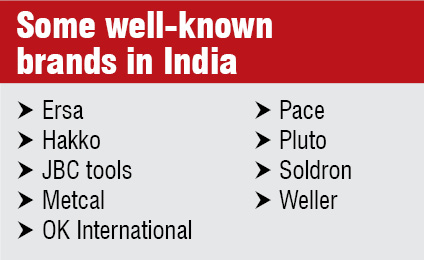
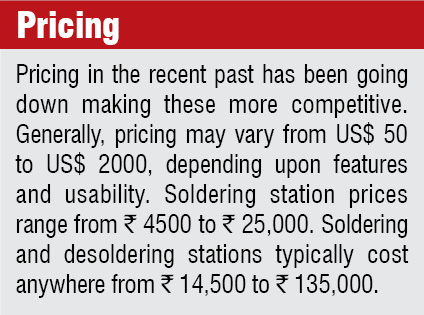
General selection criteria
Variable temperature and replaceable hardware are the two basic criterion for selecting soldering and desoldering stations. According to Ramavallabhan, the most important factor that buyers should consider is the cost of consumables of stations and availability of components like heaters, soldering tips and other accessories. He says, “These should be reasonably priced and easily available, otherwise the maintenance cost will be more than the cost of the actual unit.”
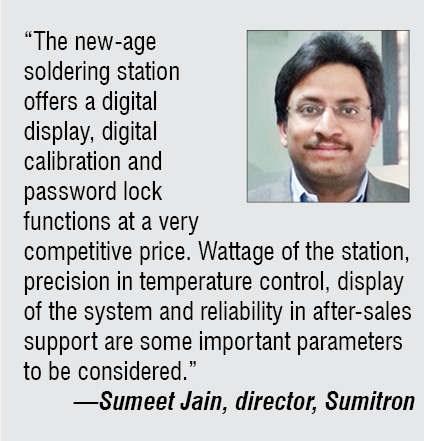 He adds, “Non-availability of accessories when required could cost you customer’s confidence and new opportunities.”
He adds, “Non-availability of accessories when required could cost you customer’s confidence and new opportunities.”
Wattage of the station, precision in temperature control, display of the system and reliability in after-sales support are some important parameters to be considered, notes Jain.
Plethora of options
From Chinese-made to established brands, there are a variety of soldering and desoldering stations available in the market with a plethora of interesting features. Application, budget and possible future uses are three important factors to strongly consider before purchasing a station.
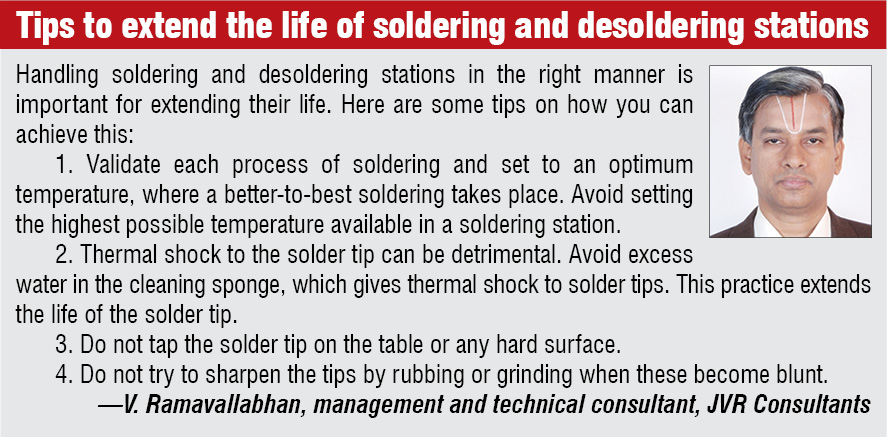 PCBs are increasingly becoming lead-free today. Major manufacturers are now making use of lead-free solder-to-solder components on boards. It could be beneficial in the long run to purchase a lead-free soldering station. Most stations designed for soldering leaded solders cannot be used for lead-free solders. Choose wisely.
PCBs are increasingly becoming lead-free today. Major manufacturers are now making use of lead-free solder-to-solder components on boards. It could be beneficial in the long run to purchase a lead-free soldering station. Most stations designed for soldering leaded solders cannot be used for lead-free solders. Choose wisely.







Sir pls help me out in desoldering an IGBT module from circuit board.what is the ideal solution for it.which desoldering station is better.pls recommened me.